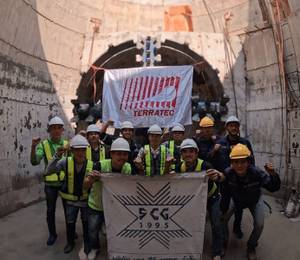Bentley Systems has recently announced its collaboration with the US-based design and consulting firm WSB to lead civil infrastructure owners and contractors to adopt infrastructure digital twins in their projects, such as highways, roads, railways, dams, bridges and airports, among others.
With this partnership, WSB will provide a new digital construction management solution and advisory service – based on Bentley’s Synchro software – to help the civil infrastructure market overcome the challenges of adopting model-based digital workflows and leveraging the power of construction digital twins.
“Construction work is too often based on 2D drawings, spreadsheets and document-based workflows, resulting in errors, waste and rework that cause most projects to be over budget and schedule,” explained Bentley Systems. Together with WSB, Bentley will now lead firms in transforming construction by adopting technology and digital delivery.
“Owners and construction firms realise that new digital workflows are needed to meet infrastructure demands, but they often face issues when determining how best to adopt technology,” said Corey Johnson, senior director of product management at Bentley Systems. “In civil infrastructure, they also face unique challenges related to the nature of the design information they receive, and the spatial logistics involved.”
WSB is the first firm to join the Bentley Digital Integrator Program for construction. This special initiative by Bentley provides programmatic go-to-market support and knowledge transfer to eligible engineering and project delivery firms and system integrators creating and curating digital twins for their clients’ infrastructure assets.
According to Bentley, WSB’s digital construction management service is targeted at the North American market. However, “we want to encourage the adoption of model-based digital workflows in the construction industry around the world,” said Mr Johnson. “If this partnership is successful, we might see more engineering firms and potential partners keen on incorporating our initiative into their service.”
Changing the way contractors deliver projects
Bentley will work with WSB to provide the tools, training, education and support required to make the digital leap. Key services offered include enabling a single source of truth by connecting project, contract and document management to the future of design – a 3D/4D/5D constructable model – as well as the ability to create constructable models from current 2D plan sets, which allows the transition to a single source of truth for all stakeholders.
“WSB promotes advanced project delivery and knows how to apply the right technology and expertise to support their clients’ aspirations for a digital future,” said Bentley Systems. “Civil infrastructure owners and contractors will overcome barriers to technology adoption to drive efficiencies from preconstruction planning through construction execution. Skills will improve as more projects adopt model-based delivery, resulting in it becoming the common standard.”
Synchro, Bentley’s construction management software that supports the entire civil construction lifecycle with simple office-to-field workflows and gives firms insight into project performance, productivity and financial health, is the foundation for WSB’s offering. Synchro is the construction service of the Bentley Infrastructure Cloud, leveraging digital twin technologies powered by iTwin.
“Clients can use Synchro to upgrade their 2D models to 3D/4D/5D digital twins, allowing for a much easier process,” said Mr Johnson. “Currently, there are not many software technology platforms on the market that have such capability.”
“WSB is committed to delivering innovative, reliable and secure solutions through the use of advanced technology. We believe the successful deployment of an operational 3D model drives transparency, maximises return on investment, makes possible true lifecycle planning, and drives collaboration to connect and align all stakeholders,” commented Jon Chiglo, chief operating officer of WSB.
“We have an entire organisation that is leading, creating, and innovating into our digital future. Our partnership with Bentley is an important part of this vision and we are excited to bring this digital construction management service to market.”
Andy Kaiyala, vice president of construction technology and controls at WSB, pointed out that to achieve higher productivity on the project, “the adoption of model-based workflows and efficient deployment of a digital twin will require all stakeholders’ participation,” and eventually, the amount of time that can be saved “will rely almost exclusively on the ability of all the contractual parties to agree on their execution plan.”
One of the challenges that WSB expects to face is convincing clients to transform their construction process. “Can we prove the new way is better? If we can, then our clients will be happy to engage in the process,” said Mr Kaiyala. “We believe there is value, and we can demonstrate that.”
Mr Johnson highlighted that it is very important to have a partner with the right experience, like WSB, because this initiative “goes beyond creating digital models. It is about changing the whole business process for civil infrastructure owners and contractors, resulting in a new workflow that they need to adapt in order to deliver projects more effectively.”
“Our digital construction management solution is not just for the largest firms working on the most complicated projects,” stressed Mr Johnson. “We want to reach out to the average, middle and typical projects that can make a difference using this technology.”
The importance of digital workflows
Many benefits can be gained from the use of model-based digital workflows, explained Mr Johnson. “Take design-bid-build projects as an example. Going by the traditional method, when the design changes, you have to restart completely from scratch. But with a model-based approach, you can easily update your design in response to new information. This means the process will be faster and more accurate, with less manpower required.”
Even in the bidding stage, while preparing a project proposal, using a model-based approach can lead to a significant reduction in time. “A lot of resource hours are usually spent on generating quantity take-offs, so if you have to work with 2D drawings, it’s going to be intensive,” he said.
“If you can perform your work faster, you can then bid more projects. You are also able to allocate more time for risk managements, and therefore you’ll have a better chance of winning the projects.”
Another benefit is that the project teams can identify issues in advance using a construction model, continued Mr Johnson. “This will minimise errors during the execution phase, which often end up with significant costs, rework, and waste of materials.”
The project teams can also use the construction model to carry out a “digital rehearsal” of the construction site. “They can walk through the site virtually to make remote decisions before work begins, such as where the equipment will be set up and how they will be transported onto the site, etc.”
Mr Johnson added that the simulation model is accessible not only via desktop, but also cloud web and mobile, “so that everyone can collaborate in real time, and conduct virtual project monitoring.”
He further mentioned that Synchro can be integrated with other software platforms if necessary. “For the most part, Synchro is also evolving as a complete construction management portfolio that covers the whole lifecycle, from construction planning to construction execution, comprising project management, cost management, and field performance management tools.”
Globally, Mr Johnson noted that northern Europe – including the UK and Nordic countries – are already far ahead in terms of digital technology adoption for civil infrastructure project delivery. “China is also advancing in that direction, and many digital solutions in these countries have been deployed on highly complex projects. Contractors are increasingly using more sophisticated model-based workflows as they can achieve greater ROIs.”
Ultimately, it all boils down to “changing the culture of construction,” concluded Mr Johnson. This is why engineering firms like WSB come on board, to help educate the industry. “Bentley with WSB is the perfect combination to enable project teams to resolve adoption hurdles and ensure that technology results in a step function improvement in the way that projects are delivered from design through construction execution.”
Image credits:
Image 1, 3 & 4: Bentley Systems
Image 2: WSB














